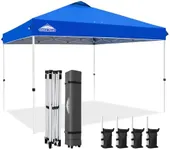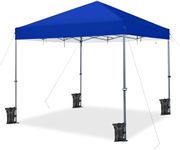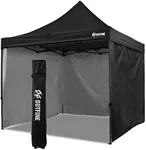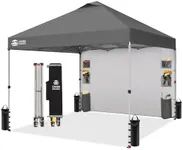Buying Guide for the Best 12x12 Canopies
Choosing the right 12x12 canopy can make a significant difference in your outdoor experience, whether you're planning a family picnic, a camping trip, or a market stall. The key is to understand the various specifications and how they align with your specific needs. By focusing on the right features, you can ensure that your canopy provides the necessary protection, durability, and ease of use.MaterialThe material of the canopy is crucial as it determines the durability and weather resistance. Common materials include polyester, polyethylene, and canvas. Polyester is lightweight and water-resistant, making it suitable for occasional use. Polyethylene is more durable and offers better UV protection, ideal for frequent outdoor activities. Canvas is the most durable and provides excellent protection against the elements, but it is heavier and more expensive. Choose a material based on how often you plan to use the canopy and the typical weather conditions in your area.
FrameThe frame of the canopy supports the structure and affects its stability and ease of setup. Frames are typically made from steel or aluminum. Steel frames are strong and durable but can be heavy and prone to rust if not properly coated. Aluminum frames are lighter and resistant to rust, making them easier to transport and ideal for frequent use. Consider the balance between weight and durability based on how often you will be setting up and taking down the canopy.
Water ResistanceWater resistance is an important feature if you plan to use the canopy in rainy conditions. Look for canopies with a high water resistance rating, often indicated by a hydrostatic head measurement (e.g., 1000mm, 2000mm). Higher numbers indicate better water resistance. If you expect to use the canopy in wet weather, opt for a higher rating to ensure you stay dry.
UV ProtectionUV protection is essential for safeguarding against harmful sun rays. Canopies often come with a UPF (Ultraviolet Protection Factor) rating. A higher UPF rating means better protection. For example, a UPF 50+ rating blocks 98% of UV rays. If you plan to use the canopy in sunny conditions, prioritize a high UPF rating to protect your skin and reduce the risk of sunburn.
PortabilityPortability refers to how easy it is to transport and set up the canopy. Features like a lightweight frame, a carrying bag with wheels, and a compact design enhance portability. If you need to move the canopy frequently or set it up alone, look for these features to make the process more manageable.
Ease of SetupEase of setup is determined by the design and mechanisms of the canopy. Pop-up canopies are designed for quick and easy setup, often requiring just one or two people. Traditional canopies may require more time and effort to assemble. If you value convenience and plan to set up the canopy frequently, a pop-up design is a better choice.
VentilationVentilation is important for maintaining airflow and reducing heat buildup under the canopy. Some canopies come with vented tops or mesh sidewalls to enhance airflow. If you plan to use the canopy in hot weather, look for features that promote ventilation to keep the area underneath cool and comfortable.
Anchoring SystemThe anchoring system ensures the canopy stays in place, especially in windy conditions. Common anchoring methods include stakes, weights, and tie-downs. For areas with soft ground, stakes are effective, while weights are better for hard surfaces. If you expect windy conditions, ensure the canopy comes with a robust anchoring system to prevent it from blowing away.





















